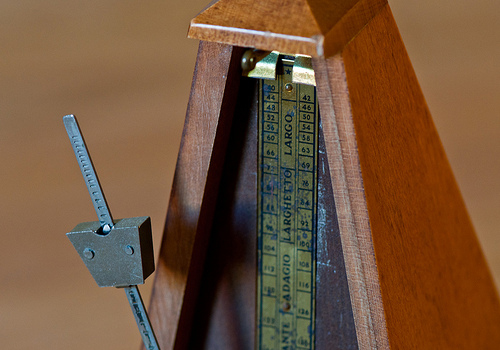Musical Fluency: Tackling Odd Rhythms

From the very beginning of my guitar-playing history, picking away at older Metallica songs, I’ve always been drawn to interesting rhythms.
This interest eventually led me from metal into prog-metal (Dream Theater), prog-rock (Rush, Yes) and complex rhythm masters like Tool and Meshuggah.
But it wasn’t until a class in college called Dalcroze Eurthymics that I could really feel these rhythms.
In that class I learned two simple things: how to feel two and how to feel three.
In this post, I’d like to show you how these two simple rhythms can help you tackle any odd meter out there.
Two
What I’m calling “feeling in two” can also be called binary rhythm. This is when the beat of the song is divided into two smaller equal beats.
Binary rhythm is the kind of rhythm typically taught in elementary school music class. A whole note divides into half notes. Half notes divide into quarter notes. Quarter notes divide into eighth notes.
The two feel can be visualized as a metronome ticking, or a ball bouncing up and down. There’s a sense of back and forth, which is counted as "one-and, two-and, three-and, four-and."
Feeling two seems to be the most natural rhythm for a lot of people. It makes sense, given that we have two legs and basically walk in a two rhythm.
Try out this simple exercise on an E minor chord to get a feel for binary rhythm.

Three
“Feeling in three” can also be called ternary rhythm. In three, each beat of the song is divided into three smaller equal beats.
Ternary rhythm has more of a circular feel to it than the back and forth feeling of binary rhythm. Count "one-and-a, two-and-a, three-and-a, four-and-a," accenting the number each time.
In ternary rhythm the beat is written as a dotted quarter note, divided into three eighth notes.
Here’s another simple exercise designed to give you a basic feel for ternary rhythm.

Building Odd Rhythms
Step one for building odd rhythms is to make sure you can switch back and forth between binary and ternary feel at any time.
Repeat the binary exercise from above four times, and then switch into the ternary exercise while keeping the eighth note the same tempo. When that’s comfortable, try repeating each exercise only twice before switching. Finally, switch back and forth from binary to ternary with each repetition.
If you can switch between these two feels at any time then you can play any odd rhythm out there. Just break down the odd rhythm into twos and threes.
Five is just two plus three, or three plus two. Seven is just three, two, two. Or two, three, two. Or two, two, three.
Come up with your own odd rhythms by combining the binary and ternary rhythms from above. As the rhythm becomes comfortable, try different chord shapes.
For a challenge, give a listen to Dave Brubeck’s “Blue Rondo A La Turk,” and see if you can break the intro down into twos and threes. (Hint: Start off with two, two, two, three).
Image courtesy of James Lee
Ben Rainey works as a guitar teacher and freelance guitarist in the Pittsburgh area. He's also in charge of music content at Tunessence.com.
Get The Pick Newsletter
All the latest guitar news, interviews, lessons, reviews, deals and more, direct to your inbox!










